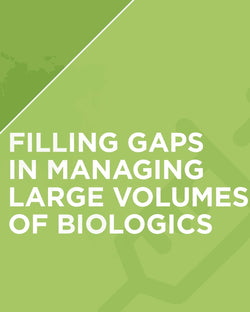Bioprocessing – everything you need to know
Bioprocessing is the process of using living organisms, cells, or their components to produce useful products. It plays a crucial role in various industries, including biopharmaceutical manufacturing, but also the production of food and biofuels.
Bioprocessing in the biopharma industry employs a range of techniques, including fermentation, purification, and downstream processing. It has numerous applications in different fields, including the production of biologics, vaccines, monoclonal antibodies (mabs), and biotherapeutics.
This article will shed light on various aspects of bioprocessing, from its definition and importance to the involved process steps. We will also highlight the role that biopharmaceutical end-to-end solutions based on single-use technology will not only play in the future, but are already playing.
Bioprocessing – a definition
Bioprocessing is defined as the sum of techniques involved to develop products with specific characteristics on the basis of living cells or parts of such. With bioprocessing, the biotech industry is able to contribute to the progress in various fields, from the food industry and the production of biomass to novel drug development.
What is a bioprocess?
A bioprocess is a method or series of operations that utilizes living cells or biological components to produce a desired product, such as pharmaceuticals, chemicals, or biofuels. It involves the cultivation and manipulation of biological systems on a large scale to achieve specific industrial or scientific objectives.
Read more: Bioprocess solutions - advancements with single-use technology [[1]]
Bioprocessing in biopharmaceutical manufacturing
Bioprocessing is an essential part of biopharmaceutical manufacturing (biomanufacturing), which involves the production of drug products made from living cells or organisms.
Cell culture is an important aspect of biopharmaceutical manufacturing as it involves the growth of mammalian cell lines, which are used to produce the desired products. Bioprocessing also involves the use of bioreactors, which provide an environment for the growth of cells and microorganisms. Bioprocess engineering and optimization are critical in the development of large-scale production processes that are efficient and cost-effective.

Bioprocessing techniques
Bioprocessing employs various techniques, including fermentation, purification, and downstream bioprocessing, to produce desired products. Fermentation is a process of converting sugars into alcohol or organic acids using microorganisms such as bacteria, yeast, and fungi.
Purification involves the separation of the desired product from the mixture of products produced during fermentation. It involves the use of techniques such as filtration, chromatography, and centrifugation.
Downstream bioprocessing involves the final steps in bioprocessing, which include formulation, packaging, and distribution of the final biological product.
Upstream bioprocessing
Upstream processing is critical to the success of bioprocessing, as it sets the foundation for the quality and quantity of the final product. In bioprocessing, upstream bioprocessing refers to the initial stages of the production process in which biological materials are prepared and optimized for downstream bioprocessing.
This stage requires broad knowledge from the field of microbiology, as it involves the cultivation of microorganisms or cells that are used in the production of biopharmaceutical products.
Process development begins with the selection of the appropriate microorganism or cell line, followed by media development, which involves selecting the optimal nutrient composition and environmental conditions to promote growth and productivity.
The next step is inoculation, where the selected microorganisms or cells are introduced into the media and allowed to grow and multiply. This is followed by fermentation or cell culture, where the cells are cultivated under controlled conditions, including temperature, pH, and oxygen levels.
During this stage, various parameters are monitored and controlled to optimize growth and product formation. These parameters include agitation rate, dissolved oxygen concentration, and nutrient addition rates.
After fermentation or cell culture, the cells are harvested and processed to extract the desired product, which is then purified in downstream bioprocessing.
Upstream processing with single-use systems – learn more
Downstream bioprocessing
Downstream bioprocessing in bioprocessing describes the purification and separation of the desired product from the complex mixture of biological material obtained from upstream bioprocessing. The objective of downstream bioprocessing is to isolate, purify, and concentrate the target product to a level that is suitable for use in pharmaceuticals, vaccines, and other biopharmaceutical applications.
The first steps in downstream bioprocessing are harvest and filtration, followed by primary capture, buffer exchange and concentration.
The next step is purification, where the target product is isolated and purified from the mixture of impurities and raw materials. This is achieved through a combination of chromatographic techniques such as ion exchange, size exclusion, affinity, and hydrophobic interaction chromatography.
After purification, the product is concentrated to remove any remaining impurities and to increase the concentration of the target product. This can be achieved by various methods such as ultrafiltration, evaporation, or precipitation.
The final step in downstream bioprocessing is formulation, where the purified and concentrated product is formulated into the final product format, such as a liquid or lyophilized powder. The product is then subjected to validation and quality control tests to ensure that it meets the required standards.
Downstream processing with single-use systems – read more
Necessary equipment – what is needed in bioprocessing?
In bioprocessing, a broad variety of equipment is needed, from fill and filtration systems, freeze and thaw devices as well as storage options to shipping containers and packaging solutions. All of these have to meet high industry standards and comply with cGMP; additionally, regulatory standards have to be complied with.
The equipment needed for downstream bioprocessing includes various types of chromatography columns, filtration systems, centrifuges, and evaporators. Other equipment includes pumps, sensors, and controllers for monitoring and controlling various process parameters.
In addition to the equipment, downstream bioprocessing also requires specialized facilities such as cleanrooms and containment areas to maintain a sterile environment and prevent contamination of the product.
Overall, the equipment needed for bioprocessing varies depending on the specific product and process requirements. However, the equipment used in bioprocessing is typically more complex and specialized than that used in traditional chemical processing due to the delicate nature of the biological materials involved.

Automated bioprocessing – bringing bioprocessing to the next level
Automated bioprocessing is capable of bringing bioprocessing even further. By reducing the need for human intervention in biopharmaceutical processing, risks both for staff and the processed substances can be reduced: While employees do not risk being exposed to potentially hazardous substances, the danger of contamination, the related product loss and human error is reduced.
Additionally, efficiency in bioprocessing can be enhanced, as automated solutions are able to deliver consistent results on different scales. This can lead to an additional cost and time reduction.
[[download-1]]
Single-use bioprocessing – an ever growing market
Single-use technology is playing an increasingly important role in bioprocessing, as it not only provides flexible solutions for both small and large scale, but is also able to enhance sustainability in the biopharmaceutical industry.
As single-use solutions do not need to be prepared for multiple applications, energy, time and water consumption for otherwise required cleaning processes can be extremely reduced. Additionally, an effective waste management can make sure that the environmental impact of bioprocessing is further minimized.
As a result, single-use bioprocessing is not only cost and resource efficient, but can also help to reduce the impact that biopharmaceutical processing has on the environment.

The future of bioprocessing in biopharma manufacturing
The future of bioprocessing in biopharma manufacturing is bright, and it is expected to play a significant role in the production of various products in the future. However, there is still need for optimization: The development of new modalities such as gene therapy and the use of genetic engineering to produce recombinant proteins will require the use of biotechnology. Partnerships between companies in the life sciences industry are also essential in the development of new products and the optimization of the production process.
Automation and the use of single-use technologies are expected to play a central role in the optimization of the supply chain and the manufacturing processes, the latter of which is expected to be the basis of a more than 20 billion dollar market by 2026. Nevertheless, efficiency as well as sustainability are key advantages of single-use technologies that make them feasible to revolutionize the biotech sector.
Being convinced by the enormous potentials of SUT, Single Use Support has developed a wide portfolio of bioprocessing end-end-to-end solutions for companies around the world, allowing fast, efficient, safe and scalable biopharmaceutical processes. [[2]]
- Pharma IQ Glossary: Bioprocessing, https://www.pharma-iq.com/glossary/bioprocessing, Published
- Single-use bioprocess market, https://www.marketsandmarkets.com/Market-Reports/single-use-bioprocessing-market-231651297.html, Published
FAQ
What is bioprocessing?
+
What is bioprocessing?
Bioprocessing is the process of using living cells, organisms, or their components to produce useful products.
What are the advantages of single-use bioprocessing?
+
What are the advantages of single-use bioprocessing?
Advantages ofsingle-use bioprocessinginclude lower energy and water consumption as well as higher levels of process efficiency, safety and sustainability.
What are the applications of bioprocessing?
+
What are the applications of bioprocessing?
Bioprocessing has numerous applications, including the production of biopharmaceuticals, food, and biofuels.
What are the techniques used in bioprocessing?
+
What are the techniques used in bioprocessing?
The techniques used in bioprocessing include fermentation, purification, and downstream bioprocessing.
What are the benefits of bioprocessing?
+
What are the benefits of bioprocessing?
The benefits of bioprocessing include sustainability, cost-effectiveness, and high-quality products.
What is the future of biopharmaceutical processing?
+
What is the future of biopharmaceutical processing?
The future ofbiopharmaceutical processingis expected to result in an even bigger role for biopharma manufacturing. This comes with the development of new drug products and therapies, which bring new requirements in bioprocessing technology.

Download eBook
eBook: Filling gaps in managing large scale volume of biologics
This eBook gives you more insights about:
- What gaps need to be filled in bioprocessing?
- Hurdles to overcome in handling pharmaceuticals
- New approaches to tackle these challenges
- Future Prospects: A glimpse into the crystal ball
